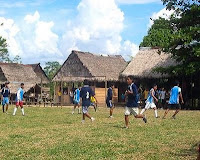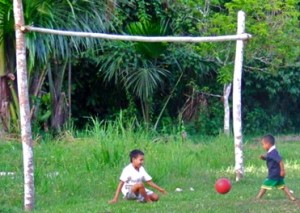 |
As of January 2009, for the season running from February until December, Colegio Nacional Iquitos has been promoted from the Segunda Division to the Primera Division of Peru. This is very important news.
Soccer — which is, of course, fútbol — is played and followed with almost religious intensity throughout Perú. According to sociologist Julio Cotler, soccer played a major role in forging a Peruvian national identity when, in 1970, the Peruvian national team surprisingly eliminated top-ranked Argentina to qualify for the Mexico Cup. For the first time, the games were broadcast nationwide, and soccer became a national passion.
Indeed, in 1996, when Tupac Amaru Revolutionary Movement guerrillas captured the Japanese embassy in Lima and held 72 hostages for 126 days, the occupation was broken by a surprise raid when the guerrillas had gathered for their daily afternoon soccer game.
Iquitos has two professional soccer clubs — Colegio Nacional Iquitos and Hungaritos, the Hungarians — and several amateur leagues, as well as an endless stream of pick-up street games, which can last for hours, and are played right through the pouring rain. Ribereño villages throughout the Upper Amazon have soccer fields, and often a game is played every day in the evening.
 |
Because some of these ribereño villages are small, they often play a downsized version of soccer called fulbito, with five or six players on a side. Famed writer Mario Vargas Llosa, in his novel The City and the Dogs, describes a fulbito game: “They wore sneakers, … and they made sure the ball was not fully inflated, to keep it from bouncing. Generally they kept the ball on the ground, making very short passes, and trying for goals from very close, without kicking hard.”
Fulbito is thus a close sport, sometimes even played indoors; the MRTA guerrillas were playing fulbito in the embassy grand dining room when the raid occurred. Some commentators have claimed that playing fulbito rather than soccer from childhood has kept Peruvian soccer players from developing kicking power, so that they are considered skilled rather than strong opponents.
Games played against neighboring villages are a major social event, and may involve three or four communities, with wagering, feasts, beer, dancing, and battery-operated CD players blaring cumbias. These games can be very exciting, especially in the rainy season, because the fields become quite muddy and slippery, with spectacular wipe-outs, and everyone winds up covered in mud.
The acculturation of indigenous groups to the ribereño lifestyle almost inevitably includes the adoption of soccer.

- Previous Post: The Survival of Plant Knowledge
- Next Post: Hallucinogens and Pornography
- More Articles Related to: The Amazon



Tira
chuta
y
Goooool!!
I was in Peru during the Euro Cup this past summer. I got caught up in the wave of excitement. Everywhere there was a TV, a game was on. In my opinion, soccer is way better than American Football. I wish it would be more popular here. Next semester I hope to take a soccer course offered at my college. I hope it will work out!
I must confess that I enjoy watching American football more than I enjoy watching soccer. What does that say about me? Of course, I always think of George Carlin’s wonderful football and baseball routine, which makes me laugh every time I hear it.
I cheer for Boca, el Barca, Brasil’s selection and my national team.
But I love them Bears! (even if they lose)